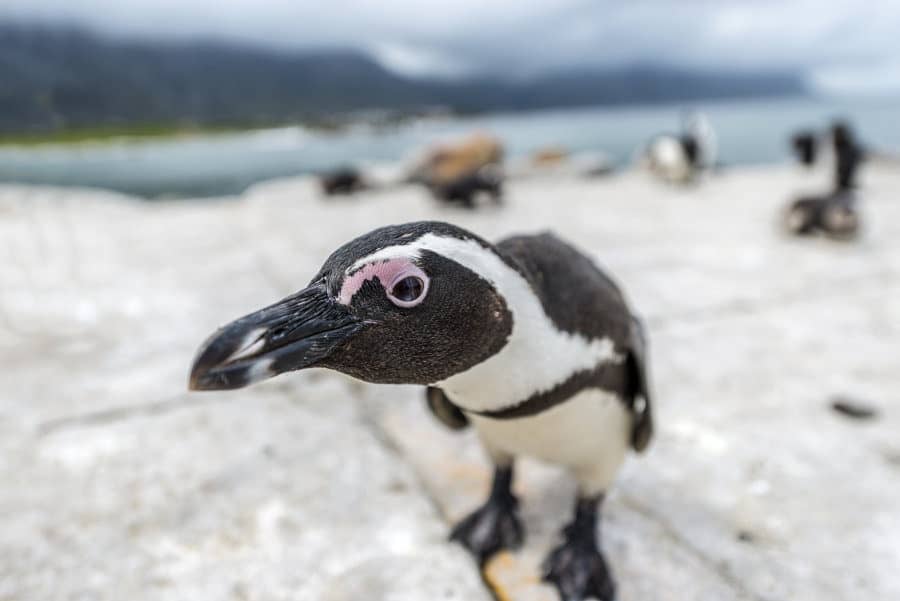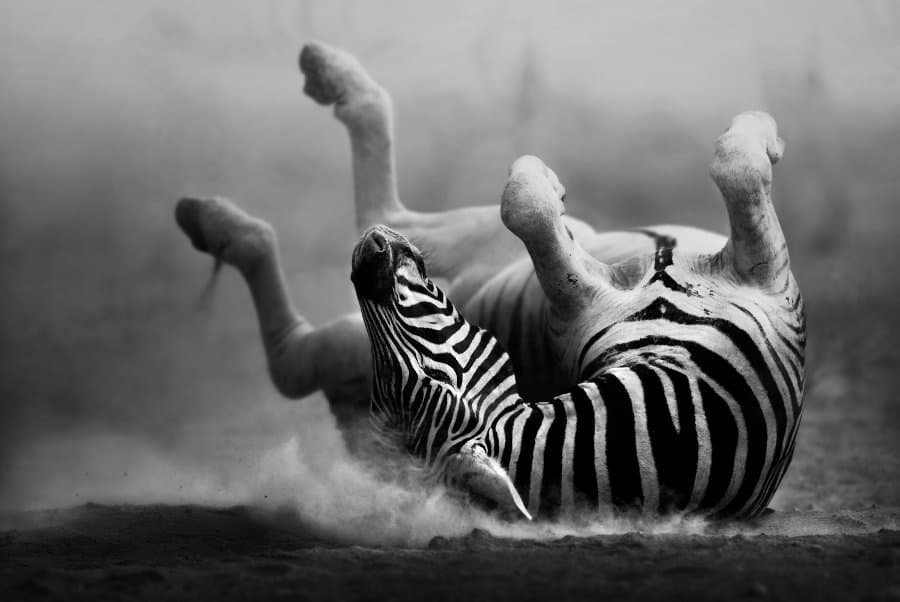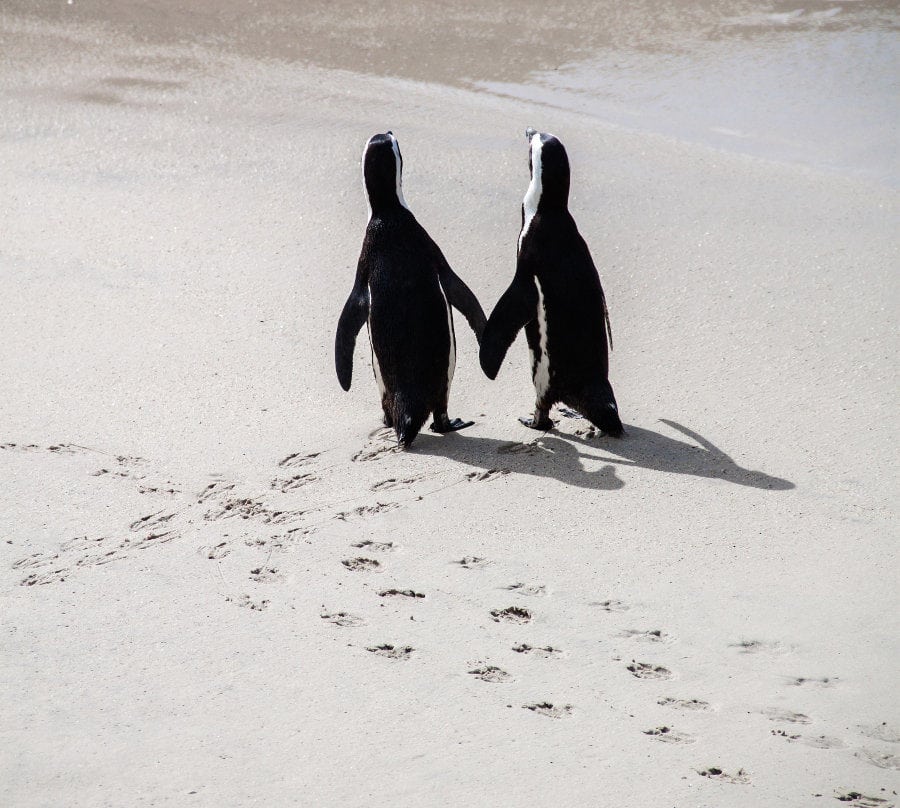African penguins are one of the cutest as well as the clumsiest land animals. It is funny to watch them waddle and hop on land. Yet, as uncomfortable as they seem on land these extraordinary animals can fly underwater.
Penguins are flightless aquatic birds with heavy bones that makes it easy for them to dive deep underwater.
They are one of the cutest animals in the whole of Africa. You can even waddle with them at a beach near Cape Town. Here is the full story of the African penguin.
Where Does the African Penguin Live?
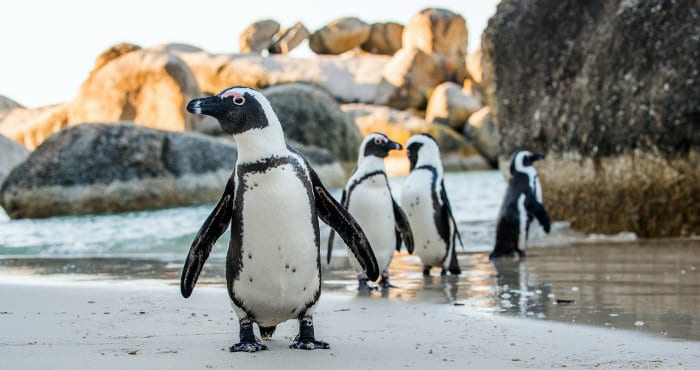
When you think of a penguin you think ice, fat bellies and fish. However the African penguin prefers a more temperate climate. They have evolved to handle cold temperatures and successfully hold on to a bit more of the sun and surf.
Visitors will find that the African penguin’s home is on the southern tip of Africa. They mostly inhabit islands off the coasts between Namibia and South Africa.
In South Africa you can find colonies of them in the western coastal areas, such as Boulders Beach in Simon’s Town and Stoney Point in Betty’s Bay.
In their colonies they often make their nests between rocks and under bushes. These birds are known to prefer nests dug out of guano, seabird and bat excrement commonly found in these areas.
Recently their habitats have been threatened by the removal of guano for commercial fertiliser. Visitors also present a potential threat, so be careful where you walk in their habitat as you might bump into a breeding pair or their nest.
What Does the African Penguin Do All Day Long?

The African penguin spends most of its day lying about in groups basking in the sun, taking a swim to cool down and fishing.
At sea they can swim very fast and are very agile in the water. They’re known to swim at 7 to 24 kilometers an hour! These birds can also dive up to 100 metres deep and the distances they will swim puts us humans to shame – African penguins can swim up to 45 km a day!
African Penguins love their food and will gain and lose half of their body weight continuously throughout their lifetime (see section on molting).
They love to eat small fish (like anchovies), squid as well as crustaceans and are very good at catching them, in part because they can hold their breath for up to 2 1/2 minutes!
The sunbathing African Penguin
Sunbathing is a big part of their day. When they bask in the sun they turn their black backs to the sun and turn their flippers and faces away from the sun. This helps them heat up faster.
The African penguin has a small pink patch above its eye that helps regulate its body temperature. As their body temperature increases, blood is sent to the glands at the pink patch.
The patch then turns darker and this in turn causes the dark glands to cool down. It’s not uncommon to see these birds panting in excessive heat.
Nesting, swimming and avoiding predators
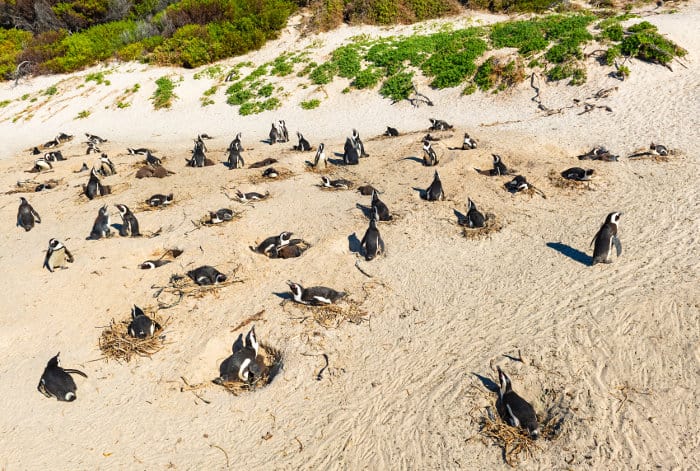
When African Penguins are not laying out in the sun or fishing, they are most likely to be looking after their nests and young. This involves navigating the various dangers and potential predators on land as well as at sea.
When they go swimming, they run the risk of bumping into Cape fur seals, great white sharks and occasionally killer whales. These are some of the African penguin’s natural oceanic predators.
On land, the fully grown adult mainly faces predators such as mongooses, jackals, Cape gannets, domestic cats or even leopards. Their nests, with either eggs or chicks, may sometimes be plundered by kelp gulls, rats and African sacred ibises.
How the African Penguin Expands its Colony: Here is Their Breeding Story
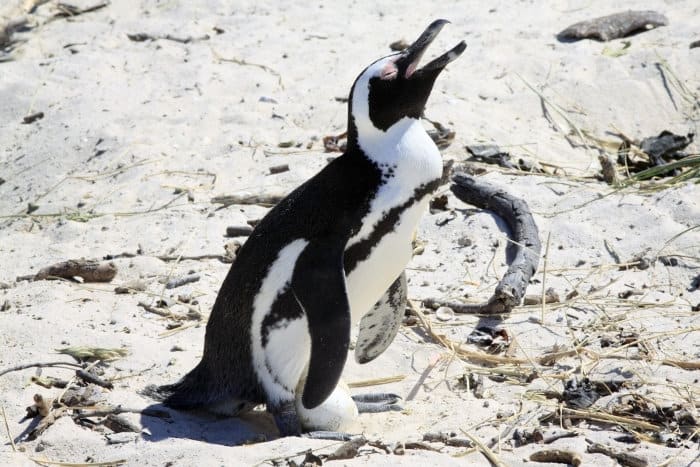
The African penguin enjoys open fields close to the ocean with almost no vegetation other than some indigenous grasses and rocks. This causes them to compete with Cape fur seals, gannets, cormorants and other sea birds for breeding habitats.
These birds are monogamous throughout their lifetime when breeding together goes well. They will only take another partner if the breeding process did not go well. The breeding pair are habitual and will always return to their preferred nesting area with the colony they know.
Due to the African penguins adaptability to both hot and cold climates their breeding season can happen any time of the year. The peak period differs from location to location, for example on Namibian coasts they will breed between November and December, and in South Africa it will be between March and May.
Nests and the breeding cycle

African penguin nests are usually burrowed in layers of guano. But due to the growing demand for fertiliser, this option is not always a viable one for the breeding pair.
They must resort to other alternatives, such as rock crevices, bushes or tall grasses and more recently, manmade nests.
The breeding pair line the nest with various objects like seaweed, feathers, plant debris and rocks. The female will then usually lay two eggs.
During the incubation period, the roles of the pair are equally shared as both sexes have an incubation ‘pouch’ to keep the temperature of the eggs consistent.
The parent that is not sitting on the nest provides supportive duties like catching fish and collecting nesting material. How cute! it just makes you love them more!
The two eggs will generally hatch but not at the same time. Once they have hatched the new parents will be brooded until the chicks’ bodies have acclimatized to the weather, which is usually when they are about 15 days old.
African penguin creches!

The parents provide the chicks safety up to the 30 day mark after which they are left “alone” in chick crèches. Here they stay with other young chicks until they reach three months. During this time the parents feed them through beak-to-beak regurgitation.
It is wonderful to note how early the chicks become independent and ready to integrate into the colony.
Yet, it is a different story for the viability to reproduce. The average age an African penguin starts to breed is between 4 to 6 years.
The character of the African penguin is something to be admired, both for their maturity in breeding and the safeguarding of their young. It is something so precious to observe in nature.
African Penguins Are So Cute and Cuddly Because …
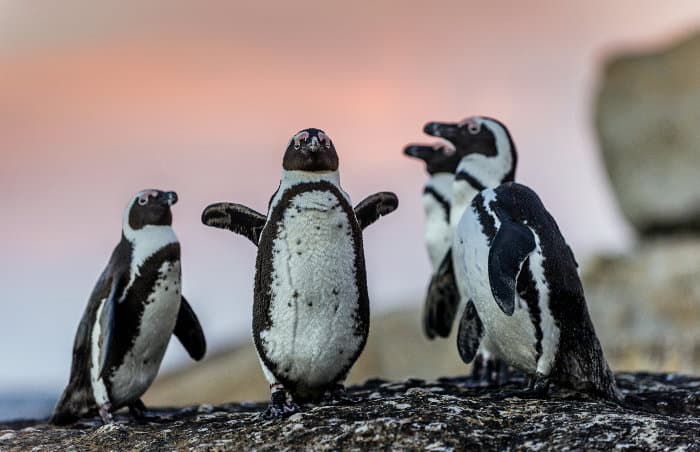
African penguins have an amazing tuxedo that does not only make them look smart, but actually camouflages them as well. This makes them very unique with their black backs and highly recognizable white bellies.
The African penguin has cute little webbed black feet that match its black facial mask. Its tuxedo is completed with a black bill and short tail. Each penguin’s markings are slightly different from another and once you get used to it, you will be able to tell them apart.
Their bodies are streamlined and cater for swimming conditions. Penguin wings have been modified to resemble flippers.
Feathers are thick and overlapping to make up a coat that provides sufficient insulation and waterproofing qualities. Unless they are molting African penguins are fully equipped to handle the southern African weather fluctuations.
The importance of molting
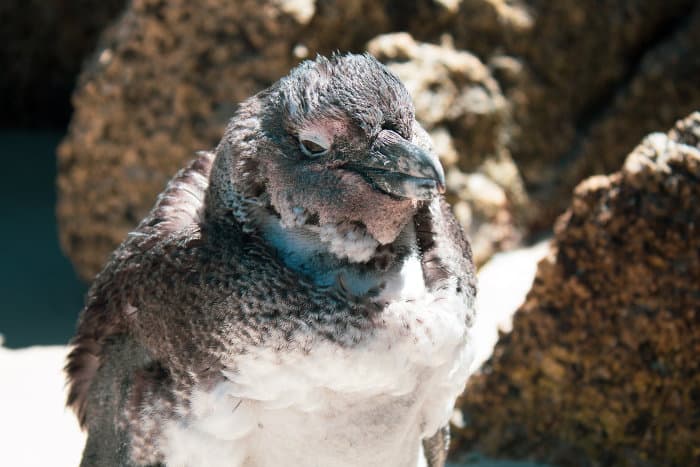
The molting process of the African penguin is very important to its survival. During a period of approximately 18 days it will not be waterproof and insulated enough to forage for food.
African penguins start their first molting 14 days after hatching and then a second time at 40-60 days. The juvenile plumage starts developing between 70-80 days.
At 70-90 days the chicks are strong and big enough to go out to sea. And they leave! Just like that! They will return to their colony when they are between one year and 22 months old to molt into their adult plumage.
African penguins molt as adults too and fatten themselves up before this period because they will lose approximately 40% of their body weight during the estimated 18-day period. This usually occurs before the breeding season starts.
Camouflage colouring

It is difficult to tell the male and female penguins apart as they have the same plumage, but if you look closely you will find that the male has a slightly bigger and broader bill. The African penguin grows up to be a 60-70 cm tall adult.
The African penguin’s colouring plays a big role in its camouflage abilities at sea. When sharks and killer whales look down towards the penguin, its black back will make it disappear next to the depth of the ocean floor.
In turn when a predator is under the penguin and looks up, its white belly will match the brightness of the sun’s rays dabbling from the surface.
Another interesting fact about the African penguin is that they have salt-water glands in their head that filter and purify sea water. They sometimes make sneezing gestures that help them get rid of salt crystals.
As cute as they are and therefore tempting to touch, it is not advisable because you should never ever touch wild wildlife.
Plus, they have very sharp beaks and can be a bit grumpy when they feel threatened. They will move their heads sideways to show you that they are nervous and stressed, so look out for this as they are not tame animals.
The Future of African Penguins
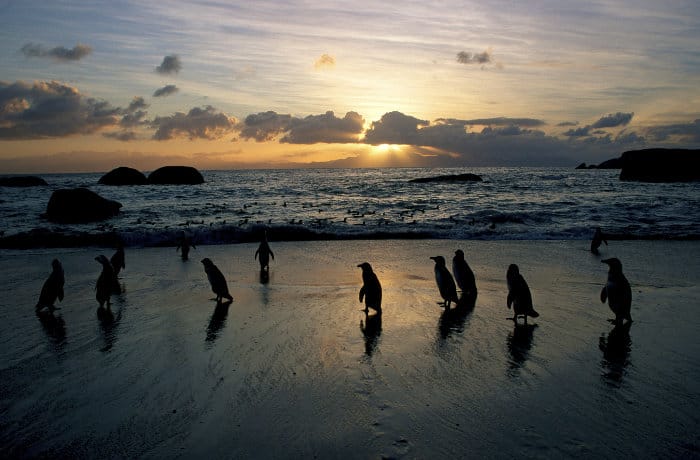
The African penguin’s life expectancy is up to 27 years in the wild. However given the many threats it faces, besides its natural predators, the African penguin has faced a population decline over the last hundred years.
There used to be an estimate of 1 million breeding pairs in the 1920s along the Namibian and South African coasts but this has been reduced to approximately 25 000 breeding pairs. 1 million to just 25 000! That’s shocking!
Threats to African penguins
The threat to the African penguin’s future is a result of habitat loss (guano removal), depletion of food sources by commercial fishing, oil spills and penguins as a food source. With this steep decline in the African penguin’s population, it is projected that they may become extinct in approximately 15 years.
The African penguin was classified as endangered in 2005 by the IUCN (International Union for Conservation of Nature) Red list and is also listed as a protected species under the NEMBA (National Environment Management: Biodiversity Act) since 2004.
The good news for penguins and penguin lovers
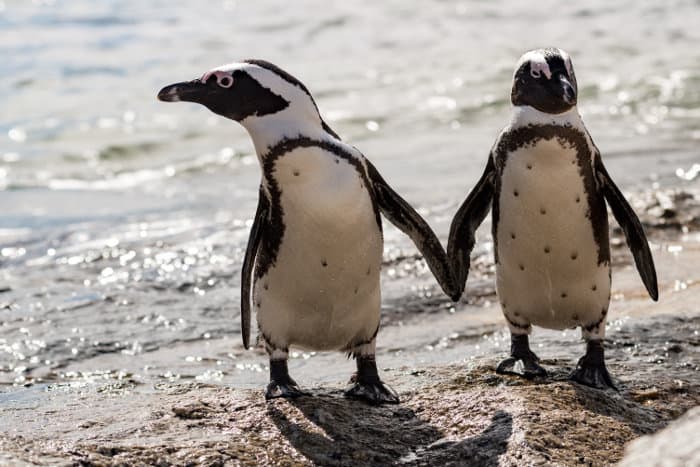
The good news is, however, that some population management actions have been introduced to help the African Penguin. These management plans include the formal protection of breeding colonies and their breeding sites by declaring them as national parks.
There is a drive to stop guano and egg collection as well as protection of food sources by prohibiting fishing in certain areas.
There are also ongoing drives to minimise disease outbreaks, and a man-made nesting provision has been made available to breeding colonies. Lastly, monitoring systems are put in place to manage the predator population sizes and also, where necessary, artificial care of abandoned chicks.
Where to see African penguins in the wild
The best place to encounter African penguins is at Boulders Beach, near Cape Town, South Africa. You can share the sand with these incredible birds and even swim alongside them.
Read more about how to swim with penguins at Boulders Beach and how to incorporate penguins into a day trip to the Cape of Good Hope.
Now that you know the current story of the African penguin you will almost certainly find that the world is a happier place with them in it. They form an incredible key part of a healthy food chain and food sources in our oceans. We must therefore protect them.
We look forward to seeing your photographs on social media when you visit them at Boulders Beach and Stoney Point!
